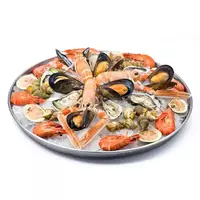Seafood

The concept of seafood is used in the food industry to refer to all edible inhabitants of the world's oceans. Although fish are marine inhabitants, this product is separated into a separate group and is not classified as seafood. The gifts of the sea are used not only in cooking, but also in medicine, as well as in the chemical industry. Almost every type of seafood has exceptional beneficial properties that have a beneficial effect on human health and well-being.
Types of seafood
There is a sufficient amount of seafood, but we will not list everything, but we will name only the most common and popular groups of inhabitants of the depths. So, the following largest types of seafood can be distinguished:
bivalves (mussels, oysters, scallops);
crustaceans (crabs, shrimp, lobster, crayfish, krill, lobster or langousse);
cephalopods (squid, octopus);
echinoderms (trepang, cucumaria and holothuria);
seaweed (kelp, red or brown);
Seafood composition
The chemical composition of seafood, as well as beneficial properties, depend solely on the variety of inhabitants of the seas and oceans. For example, shrimp meat is enriched with such useful minerals as calcium, magnesium, sulfur, iron and phosphorus. Squid or octopus meat is characterized by a large content of vitamins of group C, as well as B. As a rule, seafood contains most vitamins, as well as other useful compounds of natural origin, which are considered essential for the human body.
The calorie content of seafood is directly dependent on the species and chemical composition of the gifts of the sea. For example, mussels contain 3 grams of fat in their chemical composition, shrimp and squid contain even less. We can say that all seafood is classified as dietary and low-calorie foods. The average calorie content of seafood does not exceed 85 Kcal per 100 grams of product. If you compare all the information about the inhabitants of the deep sea, then you can see the clear benefits of seafood for human health and wellness.
Seafood benefits
The benefits of seafood extend to the entire human body as a whole. However, seafood will be most beneficial to the cardiovascular system, since the composition of the inhabitants of the depths is enriched with fatty polyunsaturated acids Omega-3,
6. In addition, seafood affects cholesterol levels. Seafood helps in normalizing digestion and metabolic processes.
Natural protein, which is found in seafood, perfectly saturates the human body, and then is just as well and easily absorbed. Seafood has exceptional beneficial properties that help keep the human thyroid gland functioning normally. Iodine and iron, which contain all seafood in its chemical composition, help in the work of the brain.
In addition, the frequent consumption of seafood helps to maintain the human nervous system in working order. People who eat seafood regularly are less likely to be stressed and depressed. Seafood is a real treasure trove of vitamins, so it's worth paying closer attention to the healthy and incredibly delicious gifts of the seas and oceans.
seafood 85 kCal
Energy value of seafood (Ratio of proteins, fats, carbohydrates - ju):
Proteins: 1 g (~ 4 kCal)
Fats: 0 g (~ 0 kCal)
Carbohydrates: 0.1 g (~ 0 kCal)
Energy ratio (bj | y): 5% | 0% | 0%
 Español
Español Français
Français Português
Português Русский
Русский 简体中文
简体中文 繁體中文
繁體中文 日本語
日本語 한국어
한국어 العربية
العربية Türkçe
Türkçe Қазақ
Қазақ Deutsch
Deutsch Italiano
Italiano Українська
Українська
